When it comes to advanced calisthenics training, nutrition plays a vital role in fuelling your body for optimal performance and achieving your fitness goals.
A well-designed meal plan specifically tailored to the demands of calisthenics can enhance muscle growth, aid in recovery, and improve overall athletic performance.
In this article, we will explore the key principles of an advanced calisthenics meal plan, including caloric needs, macronutrient ratios, nutrient timing, and the best foods to include in your diet.
Whether you’re looking to build muscle, lose fat, or enhance your athletic performance, this comprehensive guide will provide you with the knowledge and tools to optimise your nutrition for advanced calisthenics training.
Table of Contents
The Importance of Nutrition in Advanced Calisthenics
Nutrition plays a pivotal role in advanced calisthenics, significantly impacting performance, recovery, and overall results.
This assertion is substantiated by extensive research and evidence within the realm of sports science and fitness. Here’s an overview of why nutrition is crucial for advanced calisthenics practitioners:
1. Fueling Optimal Performance:
A well-balanced diet provides the necessary energy required for intense calisthenics workouts. Research, such as studies published in the “Journal of the International Society of Sports Nutrition,” highlights that macronutrients, including carbohydrates, proteins, and fats, are essential for sustaining energy levels during advanced bodyweight exercises.
2. Muscle Growth and Repair:
Advanced calisthenics often demand high levels of muscle strength and endurance. Adequate protein intake is essential for muscle repair and growth. The “International Journal of Sport Nutrition and Exercise Metabolism” reveals that protein supplementation contributes to enhanced muscle hypertrophy and strength in athletes.
3. Nutrient Timing:
Research in the “Journal of the International Society of Sports Nutrition” emphasises the significance of nutrient timing. Consuming the right nutrients at the appropriate times around workouts can maximise performance and recovery. For instance, pre-workout carbohydrates can enhance exercise capacity, while post-workout protein aids in muscle recovery.
4. Hydration and Electrolyte Balance:
Maintaining proper hydration and electrolyte balance is essential to prevent dehydration and muscle cramps during rigorous calisthenics sessions. Various studies, including those published in the “Journal of the American College of Nutrition,” demonstrate that maintaining electrolyte balance is critical for physical performance.
5. Micronutrients for Recovery:
Advanced calisthenics can lead to increased oxidative stress. Research in the “Journal of the International Society of Sports Nutrition” underscores the importance of micronutrients, such as vitamins and minerals, in reducing oxidative damage and promoting post-workout recovery.
6. Weight Management:
Achieving and maintaining the right body composition is crucial for calisthenics athletes. Research from “Medicine and Science in Sports and Exercise” indicates that proper nutrition helps in weight management, allowing for optimal power-to-weight ratio.
The Advanced Calisthenics Meal Plan: A Step-By-Step Guide
We’re all about simplicity and practicality. No jargon, no complex calculations. Here’s a straightforward, actionable guide to get you started on the path to a ripped physique:
Step 1: Assess Your Goals
Before you embark on your meal plan, you need to define your objectives. Are you aiming to bulk up, tone, or maintain your current physique? Your goals dictate your calorie and nutrient requirements.
Step 2: Calculating Your Caloric Needs
Before diving into the specifics of an advanced calisthenics meal plan, it’s essential to determine your caloric needs. Every individual has unique energy requirements based on factors such as body weight, height, activity level, and goals.
Calculating your caloric needs will serve as a foundation for building an effective meal plan that supports your training and helps you achieve your desired outcomes.
To calculate your daily caloric needs, you can use various online resources or consult with a nutritionist. These calculators take into account your basal metabolic rate (BMR), which is the amount of energy your body needs at rest, and your activity level.
For advanced calisthenics training, it is generally recommended to consume slightly more calories than your maintenance level to support muscle growth and recovery. Adding an extra 200-500 calories to your daily caloric needs is a good starting point.
Step 3: Macro-Nutrient Breakdown
While total caloric intake is essential, the distribution of macronutrients (carbohydrates, proteins, and fats) in your diet also plays a crucial role in optimising your performance and body composition.
For advanced calisthenics training, a balanced macronutrient ratio is recommended to support muscle growth, provide energy, and aid in recovery.
- Protein: The Building Block of Muscle
Protein is the most important macronutrient for advanced calisthenics practitioners. It is responsible for muscle repair, growth, and maintenance.
To maximise muscle protein synthesis and recovery, it is recommended to consume approximately 1.2-2.0 grams of protein per kilogram of body weight per day.
This can be achieved by incorporating high-quality protein sources such as lean meats, poultry, fish, eggs, dairy products, and plant-based sources like tofu, tempeh, and legumes into your diet.
- Carbohydrates: The Fuel for Performance
Carbohydrates are the primary source of energy for intense calisthenics workouts. They provide the necessary fuel to perform explosive movements and maintain high-intensity training sessions.
Complex carbohydrates, such as whole grains, fruits, vegetables, and legumes, should form the foundation of your carbohydrate intake.
Aim to consume approximately 45-65% of your total caloric intake from carbohydrates, focusing on nutrient-dense sources to support overall health and performance.
- Fats: Essential for Hormone Balance
Although often misunderstood, dietary fats are essential for overall health and hormone balance. Healthy fats, such as avocados, nuts, seeds, olive oil, and fatty fish, provide essential fatty acids and fat-soluble vitamins.
It is recommended to consume approximately 20-35% of your total caloric intake from healthy fats. However, it is essential to choose unsaturated fats over saturated and trans fats to support heart health and overall well-being.
Step 4: Meal Timing
When and how often to eat is like figuring out the optimal times to rehearse with your band to yield the best performance. Eating at the right times is critical to ensure your body has the fuel it needs when it needs it.
The timing of your meals is just as important as their content. Properly timing your meals can enhance your energy levels and the effectiveness of your workouts. The golden rule, my friend, is to listen to your body.
Step 5: Food Choices
Now that we have covered the key principles of an advanced calisthenics meal plan, let’s explore some of the best foods to include in your diet to support your training and overall health.
We’ll provide you with a list of wholesome options to make your choices easier.
- Lean Proteins
Protein is a vital component of any advanced calisthenics meal plan. Opt for lean sources of protein such as chicken breast, turkey, lean beef, fish, eggs, Greek yogurt, cottage cheese, and plant-based options like tofu, tempeh, and legumes. These protein sources provide essential amino acids necessary for muscle repair and growth.
- Complex Carbohydrates
Complex carbohydrates should form the foundation of your calisthenics meal plan. Include nutrient-dense options such as whole grains (brown rice, quinoa, oats), fruits, vegetables, legumes, and sweet potatoes. These carbohydrates provide a sustained source of energy and essential vitamins and minerals.
- Healthy Fats
Incorporate healthy fats into your diet to support hormone balance and overall health. Include sources such as avocados, nuts, seeds, olive oil, fatty fish (salmon, mackerel), and nut butter in moderation.
Pre-Workout Nutrition
Fueling your body before a calisthenics workout is essential to provide the energy needed for high-intensity training. Aim to consume a balanced meal containing carbohydrates, proteins, and a small amount of healthy fats 1-3 hours before your workout.
This will ensure that your glycogen stores are topped up, and amino acids are available for muscle repair and growth.
Intra-Workout Nutrition
During prolonged or intense calisthenics sessions, intra-workout nutrition can provide an additional energy boost and prevent muscle breakdown. Consider consuming a carbohydrate-rich snack or sports drink to maintain energy levels and enhance performance.
Post-Workout Nutrition
Post-workout nutrition is critical for recovery and muscle growth. Consuming a meal or snack containing both carbohydrates and proteins within 1-2 hours after your workout can replenish glycogen stores and kickstart the muscle repair process.
Including fast-digesting proteins such as whey or plant-based protein powders can provide a quick source of amino acids for optimal muscle recovery.
Sample Advanced Calisthenics Meal Plan
Let’s put theory into practice with a sample meal plan designed for advanced calisthenics enthusiasts. Below, you’ll find a day’s worth of meals and snacks that will help you fuel your workouts, aid in muscle recovery, and support your overall fitness goals.
Breakfast: Protein-Packed Oatmeal
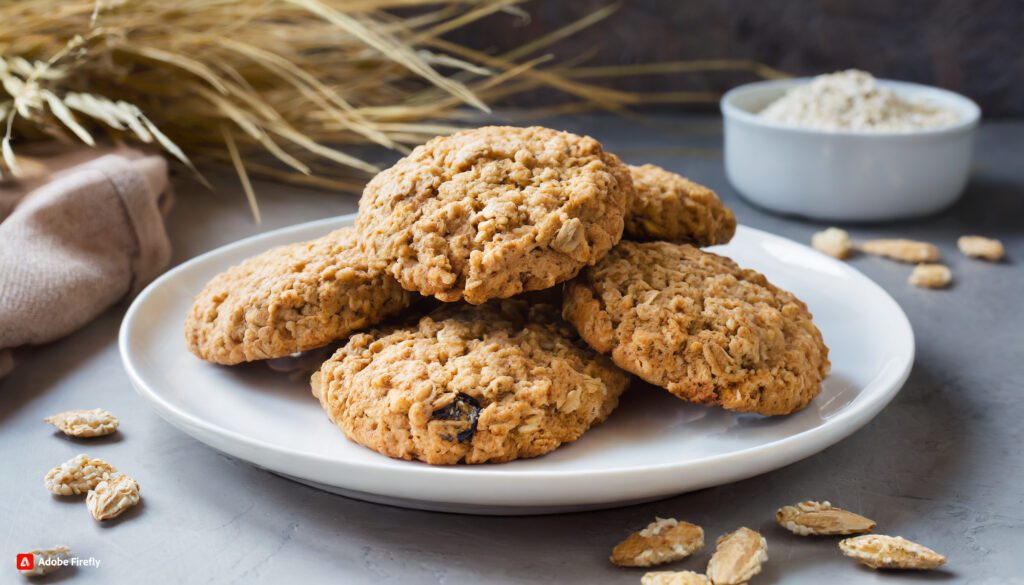
Ingredients:
- Rolled oats
- Almond milk
- Protein powder
- Chia seeds
- Sliced bananas
- Drizzle of honey
Instructions:
- Cook the oats in almond milk until the desired consistency is reached.
- Stir in protein powder and chia seeds.
- Top the oatmeal with sliced bananas and finish with a drizzle of honey.
Mid-Morning Snack: Greek Yogurt Parfait
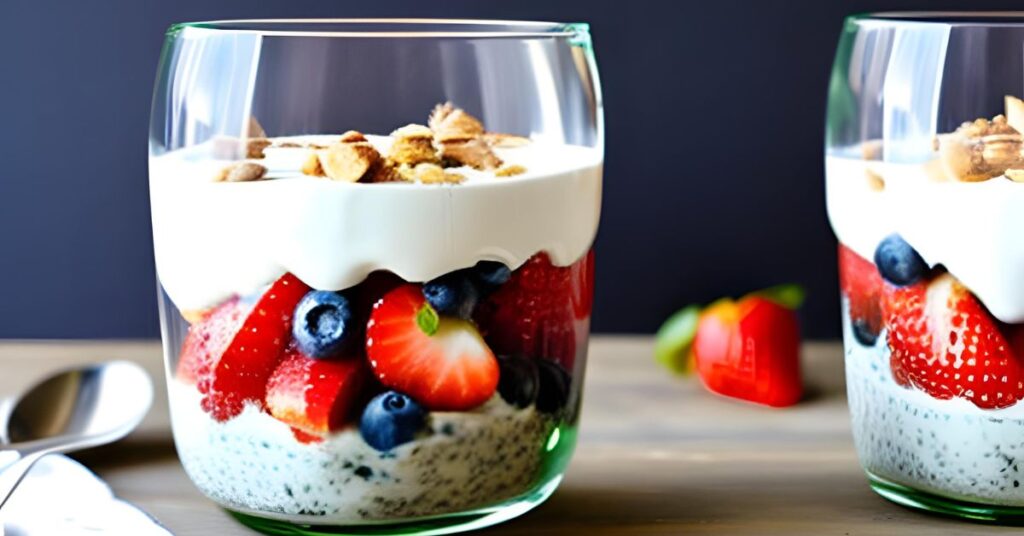
Ingredients:
- Greek yogurt
- Mixed berries
- Sprinkle of granola
- Drizzle of honey
Instructions:
- Layer Greek yogurt, mixed berries, and granola in a bowl.
- Drizzle honey on top for a touch of sweetness.
Lunch: Grilled Chicken and Quinoa Salad
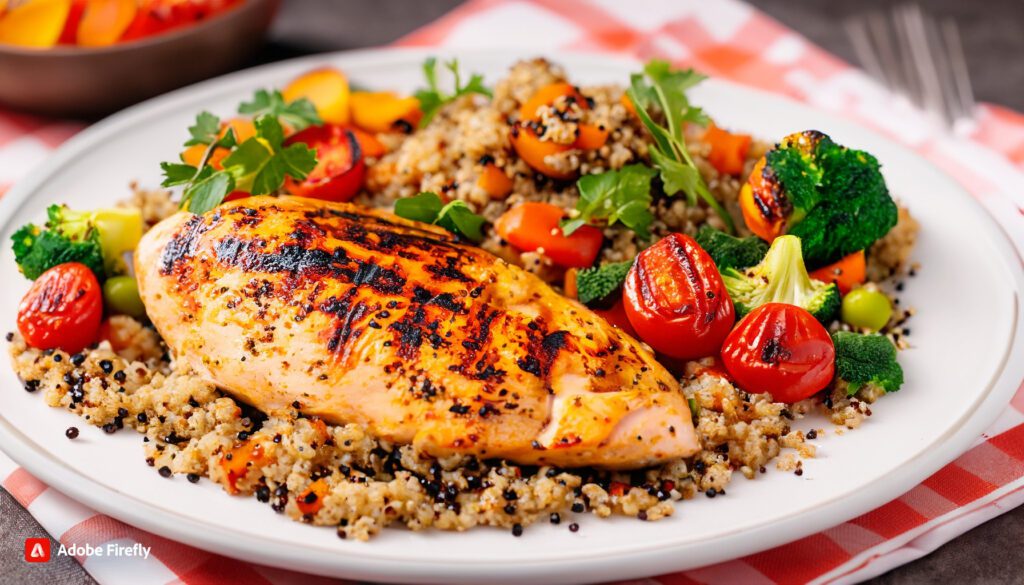
Ingredients:
- Grilled chicken breast
- Cooked quinoa
- Mixed greens
- Cherry tomatoes
- Cucumber
- Lemon vinaigrette
Instructions:
- Combine grilled chicken, cooked quinoa, mixed greens, cherry tomatoes, and cucumber in a bowl.
- Drizzle the salad with lemon vinaigrette for a zesty flavor.
Afternoon Snack: Nut Butter with Apple Slices
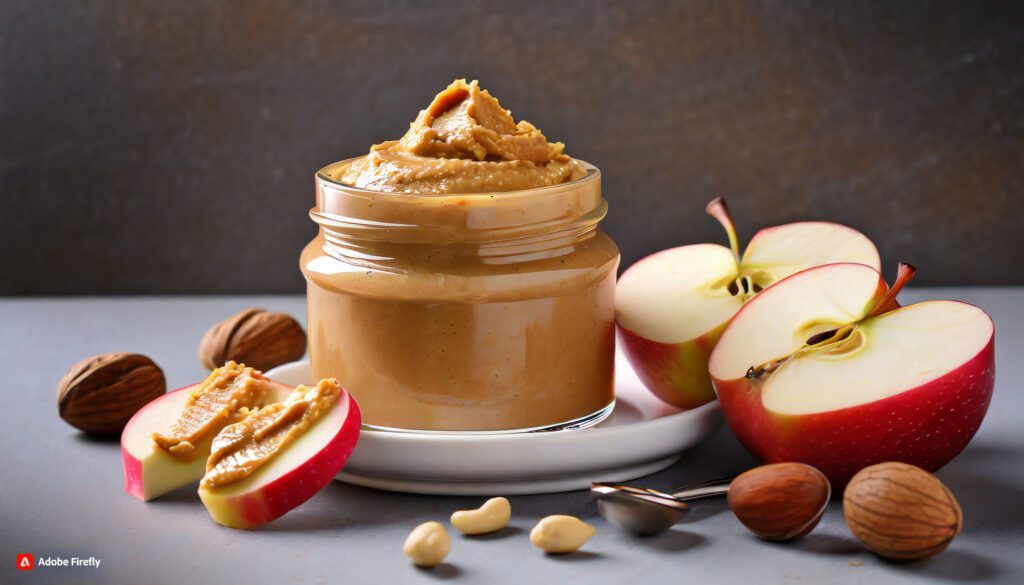
Ingredients:
- Nut butter (almond or peanut)
- Apple slices
Instructions:
- Spread your choice of nut butter on apple slices for a satisfying and nutritious snack.
Dinner: Baked Salmon with Asparagus and Brown Rice
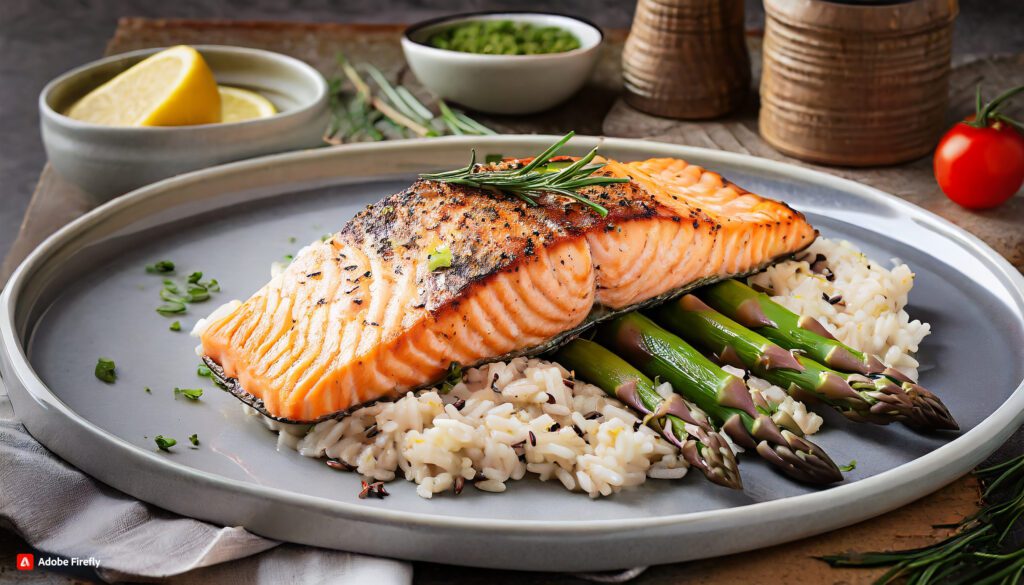
Ingredients:
- Salmon fillet
- Asparagus spears
- Cooked brown rice
- Olive oil
- Seasonings
Instructions:
- Season the salmon and asparagus with your preferred seasonings.
- Bake them in the oven until fully cooked.
- Serve with a side of cooked brown rice for a balanced meal.
Evening Snack: Cottage Cheese with Pineapple

Ingredients:
- Cottage cheese
- Pineapple chunks
Instructions:
- Top a serving of cottage cheese with pineapple chunks for a light and tasty evening snack. Enjoy!
Meal Planning Tips for Advanced Calisthenics
To ensure consistency and adherence to your advanced calisthenics meal plan, consider the following tips:
- Plan Ahead: Take the time to plan your meals and snacks in advance. This will help you stay on track and ensure you have the necessary ingredients on hand.
- Preparation is Key: Prepare meals and snacks in advance to save time during busy training days. Consider batch cooking, meal prepping, and using portion control techniques to simplify your nutrition routine.
- Listen to Your Body: Everyone’s nutritional needs and preferences are unique. Pay attention to how different foods make you feel and adjust your meal plan accordingly. Experiment with different combinations to find what works best for your body.
- Stay Consistent: Consistency is key when it comes to nutrition and achieving your fitness goals. Stick to your meal plan as much as possible, but allow flexibility for social events and occasional indulgences.
- Track Your Progress: Keep a food diary or use a nutrition tracking app to monitor your caloric intake, macronutrient ratios, and overall progress. This can help you identify patterns, make adjustments, and stay accountable.
Conclusion
An advanced calisthenics meal plan is a powerful tool for optimising your training, enhancing performance, and achieving your fitness goals. By calculating your caloric needs, balancing your macronutrient ratios, and strategically timing your meals, you can fuel your body for success.
Incorporating high-quality proteins, complex carbohydrates, and healthy fats, along with proper hydration, will provide the nutrients your body needs to excel in advanced calisthenics training. Remember to listen to your body, stay consistent, and track your progress to fine-tune your meal plan and achieve optimal results.
With the right nutrition and dedication, you can take your calisthenics training to the next level.
Disclaimer: This article is for informational purposes only and should not replace professional medical or nutritional advice. Always consult with a qualified healthcare professional before making any changes to your diet or exercise routine.

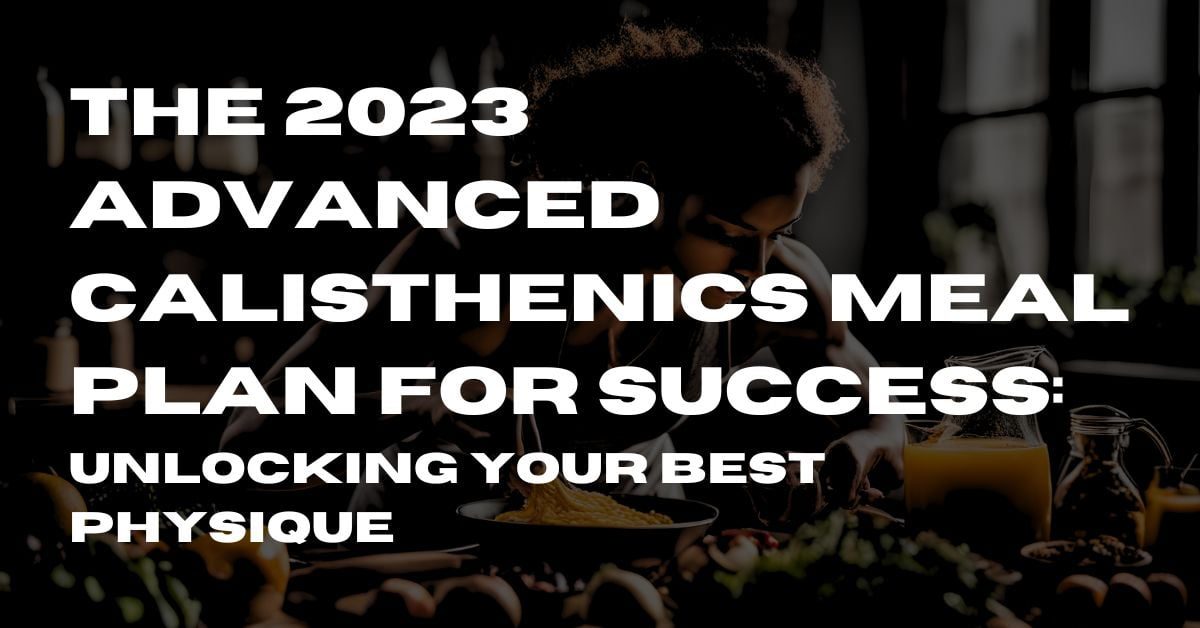
Your approach to writing content for articles is quite remarkable. What a fantastic piece! I will make it a point to check it out at a later time. I have bookmarked it. In this day and age, I find that reading really intriguing articles or reviews on the internet teaches me something new and challenging.
Thanks
very informative articles or reviews at this time.
You’re so awesome! I don’t believe I have read a single thing like that before. So great to find someone with some original thoughts on this topic. Really.. thank you for starting this up. This website is something that is needed on the internet, someone with a little originality!
Fantastic beat I would like to apprentice while you amend your web site how could i subscribe for a blog site The account helped me a acceptable deal I had been a little bit acquainted of this your broadcast offered bright clear concept
I have been surfing online more than 3 hours today yet I never found any interesting article like yours It is pretty worth enough for me In my opinion if all web owners and bloggers made good content as you did the web will be much more useful than ever before
Simply wish to say your article is as astonishing The clearness in your post is simply great and i could assume youre an expert on this subject Well with your permission let me grab your subscription to stay updated with imminent post Thanks a million and please continue up the rewarding work.
I sincerely appreciate that the website’s creator provided this amazing piece of writing here.
Fantastic site A lot of helpful info here Im sending it to some buddies ans additionally sharing in delicious And naturally thanks on your sweat
helloI like your writing very so much proportion we keep up a correspondence extra approximately your post on AOL I need an expert in this space to unravel my problem May be that is you Taking a look forward to see you
I loved as much as you will receive carried out right here. The sketch is tasteful, your authored subject matter stylish. nonetheless, you command get got an edginess over that you wish be delivering the following. unwell unquestionably come further formerly again as exactly the same nearly very often inside case you shield this hike.
Thank you for the auspicious writeup It in fact was a amusement account it Look advanced to more added agreeable from you By the way how could we communicate
I do agree with all the ideas you have introduced on your post They are very convincing and will definitely work Still the posts are very short for newbies May just you please prolong them a little from subsequent time Thank you for the post
I loved as much as youll receive carried out right here The sketch is tasteful your authored material stylish nonetheless you command get bought an nervousness over that you wish be delivering the following unwell unquestionably come more formerly again since exactly the same nearly a lot often inside case you shield this hike
Wonderful web site Lots of useful info here Im sending it to a few friends ans additionally sharing in delicious And obviously thanks to your effort